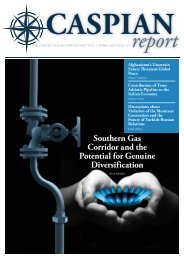You also want an ePaper? Increase the reach of your titles
YUMPU automatically turns print PDFs into web optimized ePapers that Google loves.
FATIH MACIT, HOLLY REHM<br />
10<br />
in the 1950s. However, it was not until<br />
the 1980s that large-scale fracking<br />
and shale development began in<br />
the Barnett Shale in Texas. Horizontal<br />
drilling and fracking began to be<br />
used in tandem in the early 1990s<br />
and attracted the attention of the oil<br />
and gas sector in the U.S. From there,<br />
technological innovations and adaptations<br />
through work on the Barnett<br />
and Bakken plays have greatly improved<br />
the feasibility and effectiveness<br />
of shale gas drilling. 9<br />
While fracking has been used in the<br />
U.S. for decades, plans for widespread<br />
fracking with the shale revolution<br />
have stirred controversy. Groups<br />
have raised concerns over environmental<br />
issues, including contamination<br />
of water resources, pollution<br />
caused by mishandled and potentially<br />
hazardous hydraulic fracturing<br />
fluid, methane leakages, and seismic<br />
effects, as fracking has been shown<br />
to cause to minor earthquakes. Proponents<br />
argue that with robust regulations<br />
and monitoring, fracking can<br />
be done safely and shale gas can effectively<br />
replace more harmful fossil<br />
fuels. Natural gas emits significantly<br />
less carbon dioxide and sulphur dioxide<br />
than the combustion of either<br />
coal or oil. 10 Many also argue that natural<br />
gas is a cleaner “transition fuel”<br />
as countries convert from fossil fuels<br />
to renewable energy sources.<br />
MADE IN AMERICA: DOMESTIC<br />
CONDITIONS FOR THE<br />
DEVELOPMENT OF SHALE GAS<br />
Despite other potentially large shale<br />
formations around the world, the U.S.<br />
remains the only country to have initiated<br />
the widespread development<br />
of these resources. Several arguments<br />
have been put forward to explain the<br />
success of the shale gas revolution in<br />
the U.S. Robert Blackwill and Meghan<br />
O’Sullivan sum up these arguments<br />
succinctly in their article on the shale<br />
revolution: “The fracking revolution<br />
required more than just favourable<br />
geology; it also took financiers with<br />
a tolerance for risk, a property-rights<br />
regime that let landowners claim underground<br />
resources, a network of<br />
service providers and delivery infrastructure,<br />
and an industry structure<br />
characterized by thousands of entrepreneurs<br />
rather than a single national<br />
oil company.” 11 In addition, publicprivate<br />
partnerships in research and<br />
development of shale technologies,<br />
favourable policies and regulations,<br />
established supply chains, and familiarity<br />
with oil and gas drilling have all<br />
contributed to the U.S. shale revolution<br />
and enabled the effective development<br />
of national shale resources.<br />
The unique property rights regime in<br />
America is also credited with helping<br />
spur the shale revolution. In contrast<br />
to many other countries, in the U.S.<br />
a homeowner owns their home, the<br />
land it sits on as well as the ground<br />
below and any resources contained<br />
therein. In other countries, this land<br />
would be controlled or heavily regulated<br />
by the state. Bypassing state<br />
involvement, any company able to<br />
procure an agreement with a homeowner<br />
can begin drilling on their<br />
land. This provides financial incentives<br />
for landowners to permit drilling<br />
on their land. 12 Additionally, analysts<br />
note that oil and gas drilling has<br />
taken place around the U.S. for<br />
decades, acquainting the population<br />
to drilling rigs, tankers, etc. In other<br />
areas of the world, such as Europe,<br />
the population is not familiar with<br />
these activities as most production of<br />
9.<br />
U.S. Department of Energy, “Modern Shale Gas Development” 13.<br />
10.<br />
EIA, “What is shale gas and why is it important”<br />
11.<br />
Robert D. Blackwill and Meghan L. O’Sullivan, “America’s Energy Edge: The Geopolitical<br />
Consequences of the Shale Revolution.” http://www.foreignaffairs.com/articles/140750/<br />
robert-d-blackwill-and-meghan-l-osullivan/americas-energy-edge. Accessed June 13, <strong>2014</strong>.<br />
12.<br />
Paul Stevens (2012) “The ‘Shale Gas Revolution’: Developments and Changes,” London,<br />
England, 9.










